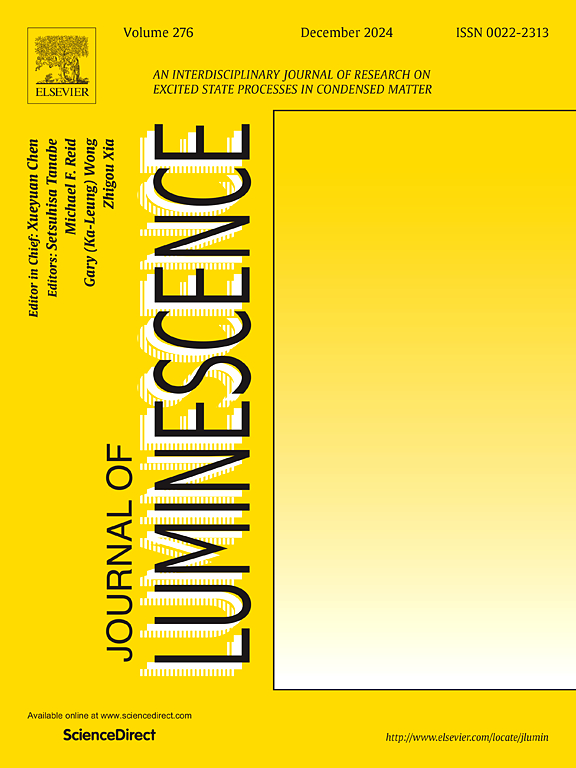Characterization and energy transfer of Sm3+/Tb3+ co-doped ZnO elaborated by auto-combustion method
IF 3.3
3区 物理与天体物理
Q2 OPTICS
引用次数: 0
Abstract
Zinc oxide undoped and co-doped with (Sm3+, Tb3+), were successfully obtained through an auto-combustion synthesis process. The optical behaviors of these materials were analyzed to determine the impact of Sm3+/Tb3+ incorporation. The structural characterization by X-ray diffraction (XRD) revealed that the samples crystallize in a hexagonal wurtzite phase. The Judd-Ofelt analysis was applied to the absorption spectra of Sm3+ (4 ) ions to further investigate their optical properties. This allowed for the determination of the three phenomenological parameters (, and ), from which theoretical radiative properties were derived. It was found that the JO parameters follow the order: > >. Photoluminescence (PL) studies revealed the presence of characteristic transitions of Sm3+ ions, with a prominent emission at 4G5/2 → 6H7/2 (600 nm). Energy transfer from Tb3+ ions to Sm3+ ions was evidenced through PL analysis and the Judd-Ofelt method. An improvement was observed in the values of and (), as well as in the measured lifetime () of the 4G5/2 → 6H7/2transition after the addition of Tb3+ ions. A noticeable increase in radiative lifetime () was recorded following the addition of Tb3+. Enhancement of photoluminescence intensity was also observed for the transitions 4G5/2 → 6H5/2 (562 nm), 4G5/2 → 6H7/2 (600 nm), 4G5/2 → 6H9/2 (650 nm) and 4G5/2 → 6H11/2 (700 nm), along with an improvement in quantum efficiency () for the 4G5/2 excited state. These findings suggest that Sm3+, Tb3+ co-doped ZnO could be a promising candidate for applications in color display technologies. The correlated color temperature (CCT) was calculated at 3013 K, supporting its potential use in LED (w-LED) applications.
采用自燃烧法研究了Sm3+/Tb3+共掺杂ZnO的表征和能量转移
采用自燃烧合成方法成功制备了未掺杂和共掺杂(Sm3+, Tb3+)的氧化锌。分析了这些材料的光学行为,以确定Sm3+/Tb3+掺入对材料的影响。x射线衍射(XRD)表征表明,样品结晶为六方纤锌矿相。采用Judd-Ofelt分析Sm3+ (4f5)离子的吸收光谱,进一步研究其光学性质。这使得三个现象学参数(Ω2, Ω4和Ω6)得以确定,理论辐射特性由此得到。发现JO参数遵循以下顺序:Ω4 >;Ω6祝辞Ω2。光致发光(PL)研究发现Sm3+离子的特征跃迁存在,在4G5/2→6H7/2 (600 nm)处有明显的发射。通过PL分析和Judd-Ofelt方法证实了Tb3+离子向Sm3+离子的能量转移。加入Tb3+离子后,4G5/2→6h7 /2相变的σe和(σeΔλeff)值以及寿命(τ平均值=1.35ms)均有改善。加入Tb3+后,辐射寿命显著增加(τrad=1.50ms)。4G5/2→6H5/2 (562 nm)、4G5/2→6H7/2 (600 nm)、4G5/2→6H9/2 (650 nm)和4G5/2→6H11/2 (700 nm)的光致发光强度增强,4G5/2激发态的量子效率提高(η=90%)。这些发现表明Sm3+, Tb3+共掺杂ZnO在彩色显示技术中有很好的应用前景。相关色温(CCT)在3013 K时计算,支持其在LED (w-LED)应用中的潜在应用。
本文章由计算机程序翻译,如有差异,请以英文原文为准。
求助全文
约1分钟内获得全文
求助全文
来源期刊

Journal of Luminescence
物理-光学
CiteScore
6.70
自引率
13.90%
发文量
850
审稿时长
3.8 months
期刊介绍:
The purpose of the Journal of Luminescence is to provide a means of communication between scientists in different disciplines who share a common interest in the electronic excited states of molecular, ionic and covalent systems, whether crystalline, amorphous, or liquid.
We invite original papers and reviews on such subjects as: exciton and polariton dynamics, dynamics of localized excited states, energy and charge transport in ordered and disordered systems, radiative and non-radiative recombination, relaxation processes, vibronic interactions in electronic excited states, photochemistry in condensed systems, excited state resonance, double resonance, spin dynamics, selective excitation spectroscopy, hole burning, coherent processes in excited states, (e.g. coherent optical transients, photon echoes, transient gratings), multiphoton processes, optical bistability, photochromism, and new techniques for the study of excited states. This list is not intended to be exhaustive. Papers in the traditional areas of optical spectroscopy (absorption, MCD, luminescence, Raman scattering) are welcome. Papers on applications (phosphors, scintillators, electro- and cathodo-luminescence, radiography, bioimaging, solar energy, energy conversion, etc.) are also welcome if they present results of scientific, rather than only technological interest. However, papers containing purely theoretical results, not related to phenomena in the excited states, as well as papers using luminescence spectroscopy to perform routine analytical chemistry or biochemistry procedures, are outside the scope of the journal. Some exceptions will be possible at the discretion of the editors.
 求助内容:
求助内容: 应助结果提醒方式:
应助结果提醒方式:


